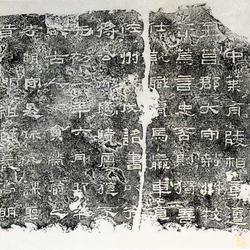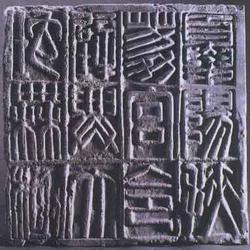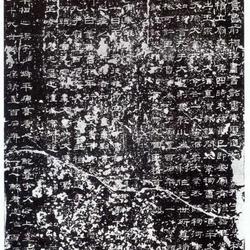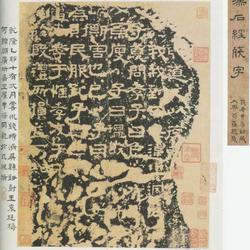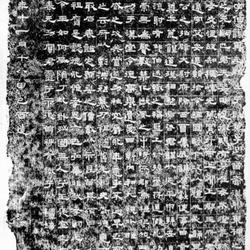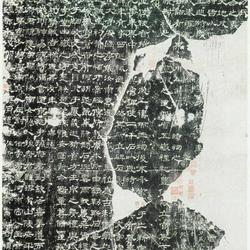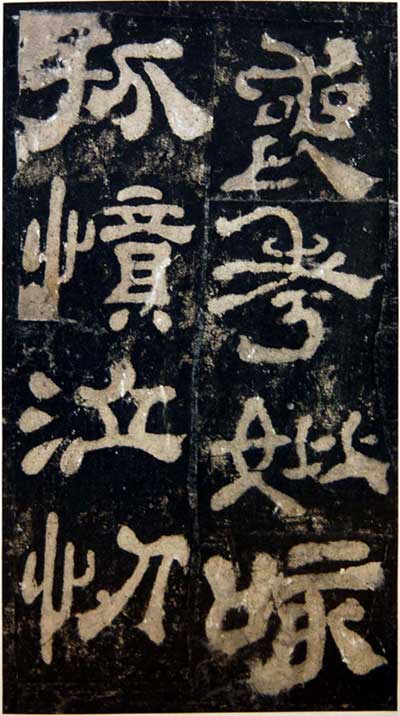
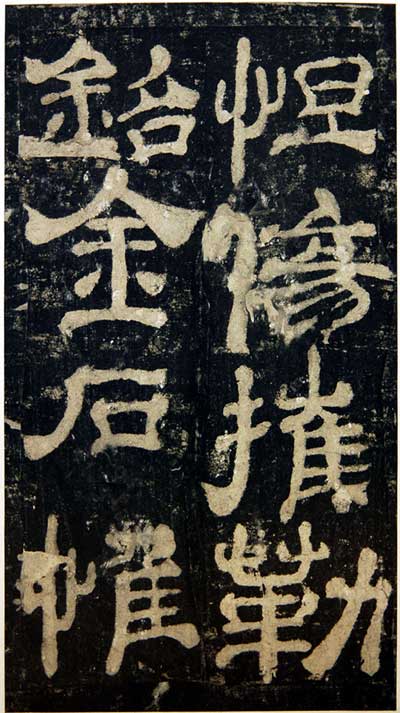
The full name of this stele is "Han Beihai Chunyu Changxia Cheng Stele", also known as "Xia Zhongyan Stele". It was established in the third year of Jianning (170 AD) in the Eastern Han Dynasty, with official script. 14 lines, 27 words per line. The postscript of Song Zhao Mingcheng's "Inscriptions on Stone" says: "The stele was in Mingzhou during the Yuanyou period (1086-1093). It was found in the soil because of the river embankment management." Guangping County in Mingzhou during the Song Dynasty was governed by what is now Yongnian County in Hebei Province. In the fifteenth year of Chenghua in the Ming Dynasty (1479), Qin Minyue, the prefect of Guangping, discovered that the stele had fallen down in the back hall of the prefecture, so he built the "Aigu Xuan" in the east corner of the hall to cover it. But the bottom half of the stele, one hundred and eleven crosses, has been cut out by later generations (see Qin Minyue's "Guangping Zhi"). In the 22nd year of Jiajing in the Ming Dynasty (1543), the city was destroyed by craftsmen due to construction. In the second year of Yue, the prefect Tang Yao took the old rubbings from Zhangchuan Academy (Zishan Academy) and carved a new stele in the pavilion. The re-engraved stele is 259.2 cm high and 124.8 cm wide, with 13 lines of text and 35 characters per line. There is an forehead, and at the end of the stele there is a line of eight characters "Cai Bojie's calligraphy in the third year of Jianning" and an inscription inscribed by Tang Yao, all of which are in official writing. Most of the surviving rubbings are reprints.
The owner of the monument is Xia Cheng, whose courtesy name is Zhongyan. His ancestors, father and brother are all in prominent positions. It is said that "favor and honor were passed down through the ages, and honors were awarded to the royal family." Inheriting literary virtues, he served successively as county clerk, postal supervisor, Wuguan Gongcao, Jizhou and other positions, until he reached Chunyuchang (Chunyu County was formerly governed thirty miles northeast of present-day Anqiu County, Shandong Province). He died in June of the third year of Jianning.
"Xia Cheng Stele" is one of the famous Han dynasty steles. Because of its peculiar knot characters, mixed official and seal scripts, and many seal and seal strokes, it has a penetrating character and a high-spirited spirit. It was designated as Cai Yong's script from King Yun of the Yuan Dynasty. Since then, many scholars have followed his theory, but there is no real evidence, so Some people raised doubts (such as Gu Nanyuan of Qing Dynasty, etc.). No matter who the calligrapher is, his calligraphy has always been highly praised, which is generally the same. For example, Yuan Wang Yun said: "The "Five Features Gong Cao Yu Xia Cheng Tomb List" written by Guan Gong (according to Cai Yong) in the third year of Jianning is a really strange pen, like a gold-cast tripod of Xia Dynasty. There are hundreds of miscellaneous things, but the clothes, etiquette and music are already embryonic in them. What is the so-called spirit that has dominated a hundred generations, and the pen has been impressive!?" ("Qiulan Collection") Ming Wang Shizhen said: "The official law always has a seal pen, which is similar to the bell ( The princes of Yao and Liang are slightly different, but they have insightful bones and wonderful flying skills. It is doubtful that Zhonglang can do it. However, Cai Ji does not record it, and other books cannot be tested. It is only for those who know it." ("Dianzhou Shanren Four Manuscripts") King Shu of the Qing Dynasty said: "The characters on this stele are particularly beautiful, and there are wonderful things that must be perfected. It cannot be ignored. The only thing that exists in the Han stele today is this. However, the Han people are simple and vigorous. Qi, the carvings here have been exhausted, and if you continue to learn, you will inevitably fall into the evil path. Looking at this, scholars should know that the ancients had this wonderland, but they could not use this wonder method." ("Xuzhou Inscription and Postscript") Weng Fanggang commented: " The body of the stele is combined with the seal script and the regular script method, which is a key step in ancient and modern calligraphy." ("Inscriptions on Metal and Stone of the Two Han Dynasties") Kang Youwei said: "Wang Yun flew with "Xia Cheng", with the wind of Zhi Ying and Dragon. The trend is that it can be regarded as the book of Zhonglang. I say that "Xia Cheng" is a different style. If it is compared with Jin Dongxin, Banqiao and the like, it is definitely not Zhonglang."
According to Zhao Mingcheng's "Inscriptions on Stone and Stone", this stele is "as good as new with its carvings. Among the more than 200 volumes of Han stele collected by the Yu family, this stele is the most complete." It can be seen that the original stone was still finished in the early Southern Song Dynasty, and it has long since passed away. It is said that the only relatively reliable original stone rubbing in existence is the Zhenshangzhai edition of Wuxi Huaxia (named Dongsha) in the Ming Dynasty, which is missing three crosses. There is a long postscript by Weng Fanggang, which is known as the only copy in the world.
[Exchange items]
Liu Youding of the Yuan Dynasty: "Beihai Chunyu Changxia Chengbei", in today's Mingzhou. During the Song and Yuan Dynasties, they were found in the soil during the construction of river embankments. The carvings are as new as new, with a strange and ancient style, which Zheng Huixi calls the eight-point seal script. ("Yanji Notes")
Wang Shu of the Qing Dynasty: The inscriptions on this stele are extremely beautiful, and if there is something wonderful, it must be perfect, and it cannot be ignored. This is the only difference among the Han dynasty monuments that exist today. However, the simple and vigorous spirit of the Han people has been exhausted here, and if they continue to learn, they will inevitably fall into the evil path. When scholars look at this, they should know that the ancients had this wonderful state, but they could not use this magical method. ("Inscription and Postscript of Xuzhou")
Weng Fanggang of the Qing Dynasty: The body of the stele is in seal script, and it is also in regular script. It is a major step in ancient and modern calligraphy. ("Episodes of the Two Han Dynasties")
Liu Xizai of the Qing Dynasty: "Yanguang Remnant Stele", "Xia Cheng Stele", Wu "Tianfa Shen Prophecy Stele", the difference can be attached to the eight-point seal script and two-point official script. However, these must be regarded as eight points, so the eight points are less That’s it. Or it can be said that Hongdu's "Shi Jing" is an eight-part body. ("Art Concept")
Kang Youwei of the Qing Dynasty: As for the legal system, the body and energy are more beneficial: Gao Hun has "Yang Mengwen", "Yang Tong", "Yang Zhu", and "Xia Cheng". ("Guangyi Zhou Shuangji")
Kang Youwei of the Qing Dynasty: I say that "Xia Cheng" is a different style. If Jin Dongxin and Banqiao are based on "The Analects of Confucius", they must not be written by Zhonglang. ("Guangyi Zhou Shuangji")

